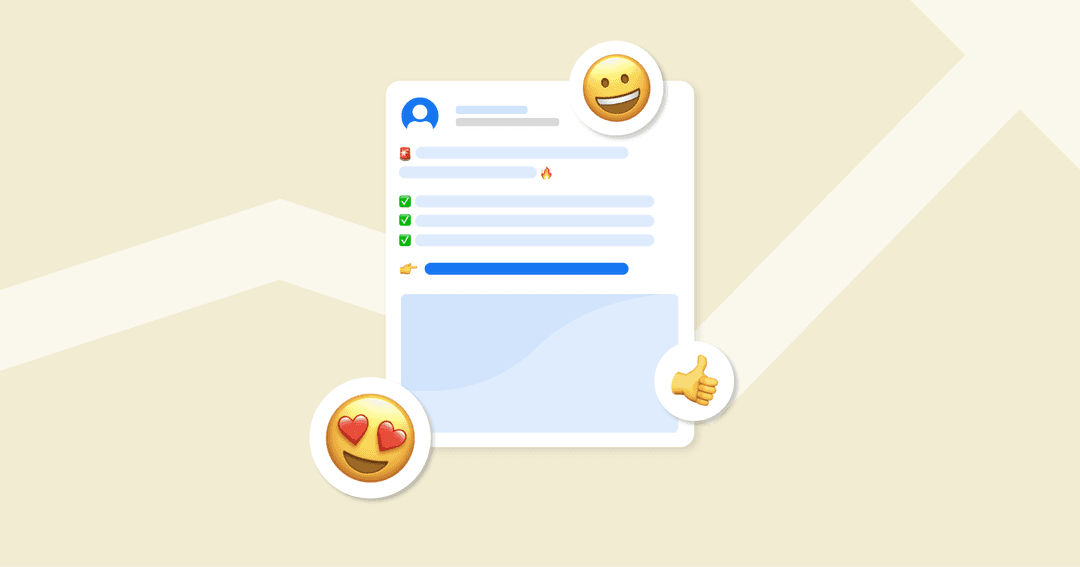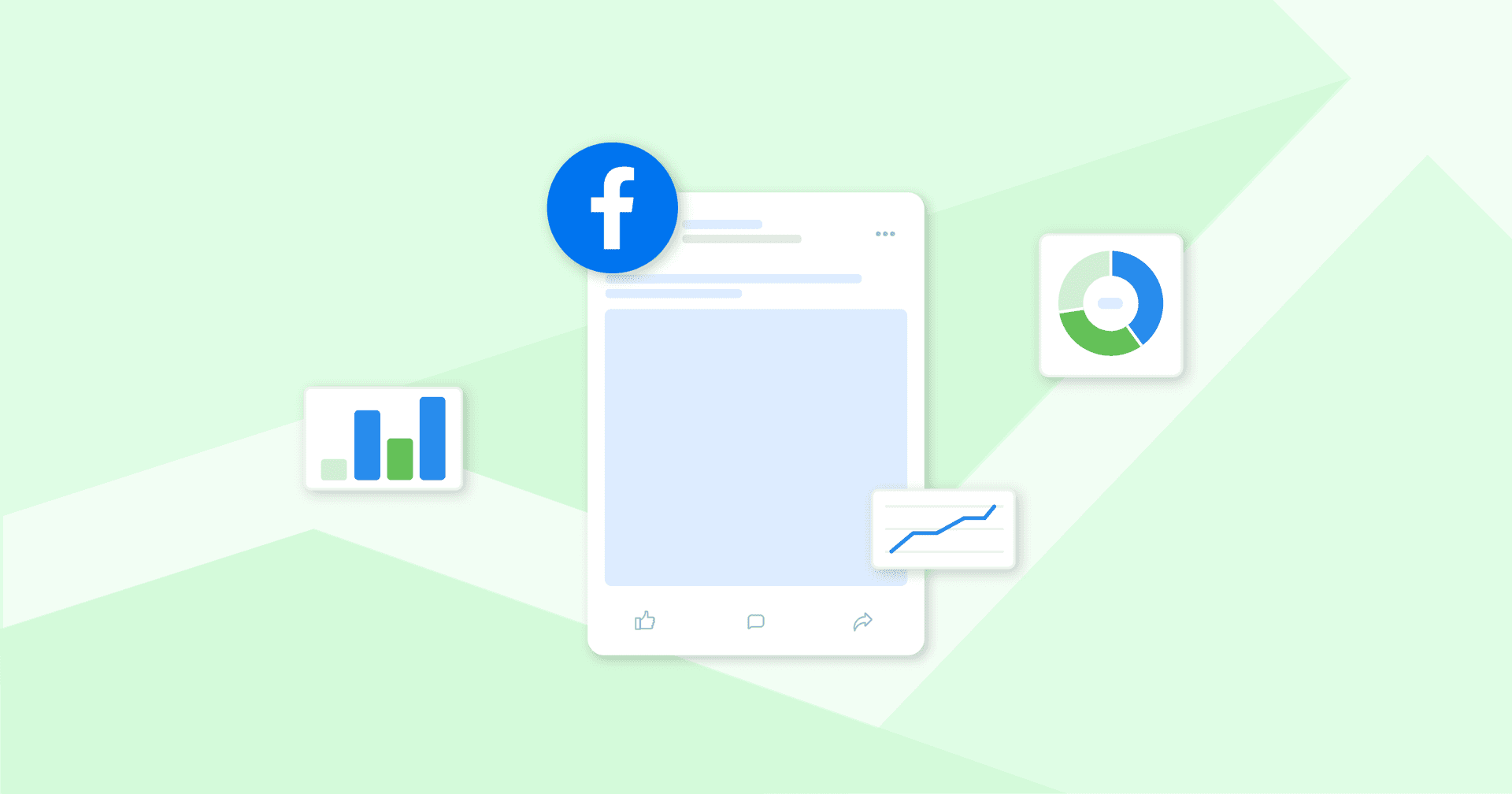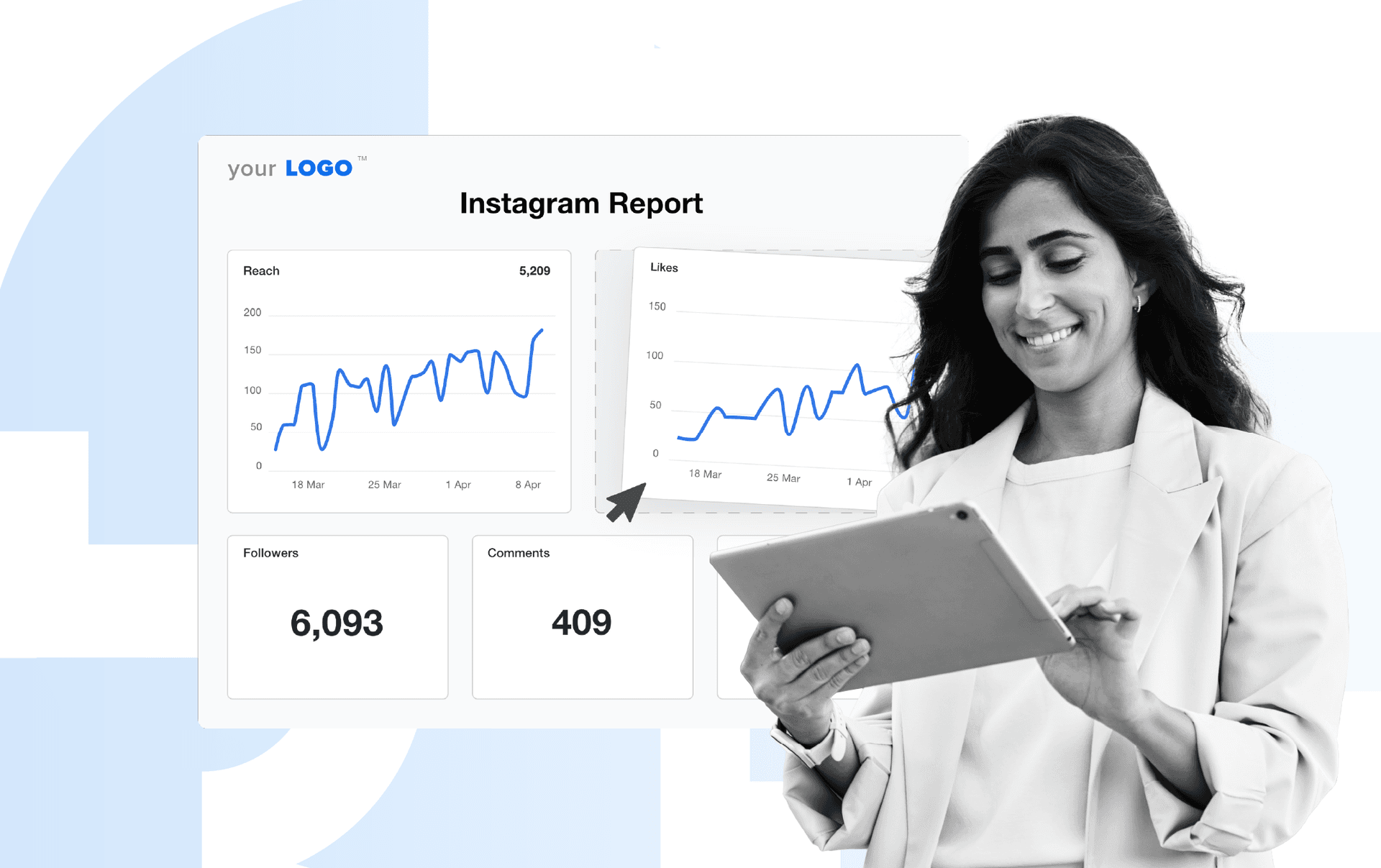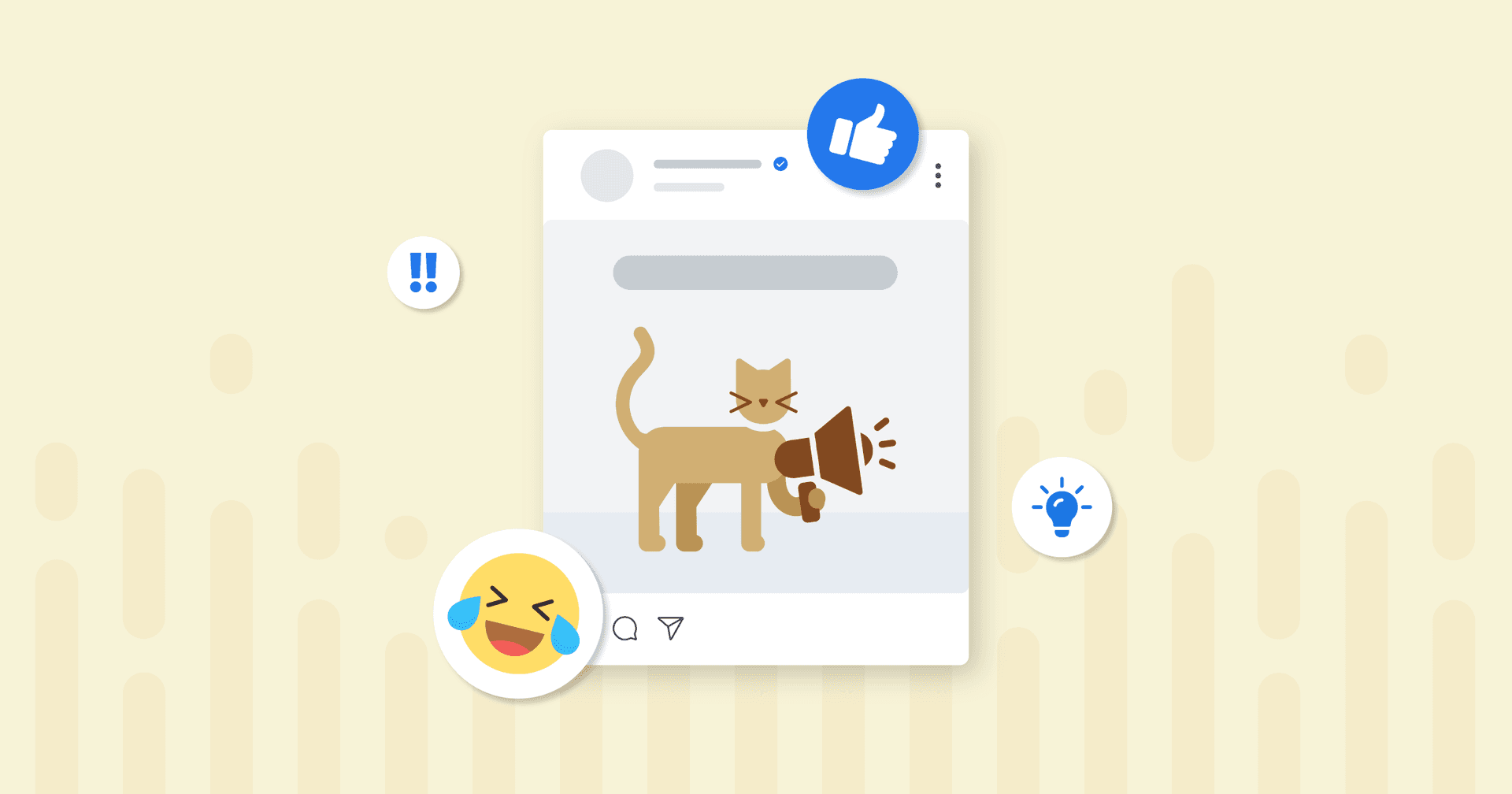Table of Contents
Table of Contents
- ⬆️ The Rise of Emoji Culture in Digital Marketing
- 👍Benefits of Using Emojis in Marketing Campaigns
- ❤️ The 22 Most Used Emojis and Their Meanings
- 🛠️How To Use Emojis to Enhance Digital Communications
- 🌎Considerations for Audience Sensitivity and Cultural Nuances
- 🚀 The Future of Emojis in Digital Marketing
- 📋Summary and Key Takeaways
7,000+ agencies have ditched manual reports. You can too.
Free 14-Day TrialQUICK SUMMARY:
Emojis are now essential in digital marketing, adding quick emotional cues that plain text can’t convey. Far beyond fun symbols, they’re universal tools for enhancing engagement and clarity. This guide covers the 22 most used emojis, offering insights to boost campaign clarity and connect with audiences on an emotional level.
Emojis have become essential tools in modern digital conversations. They transcend language barriers, adding a quick hit of emotion, context, and clarity to online messages that plain text sometimes can’t capture.
As emoji use becomes a staple in social media, email, and search marketing, understanding the most popular emojis—and what each means—will help boost your campaign’s impact. Whether it’s a friendly smile, a confident thumbs-up, or a well-placed heart, these icons create connections that words alone often miss.
In this guide, we’ll explore the 22 most-used emojis. So, if you’ve ever wondered if an emoji could help your client’s messages stand out a little more, you’re in the right place.
Let’s decode the essentials. 🔎
⬆️ The Rise of Emoji Culture in Digital Marketing
What started as a few playful symbols has evolved into a global language! Emojis have become the spice of digital communication, letting brands connect with audiences in a way that words alone can’t. These tiny icons have crossed language barriers, bringing warmth, emotion, and personality to messages—and making marketing feel a little more human.
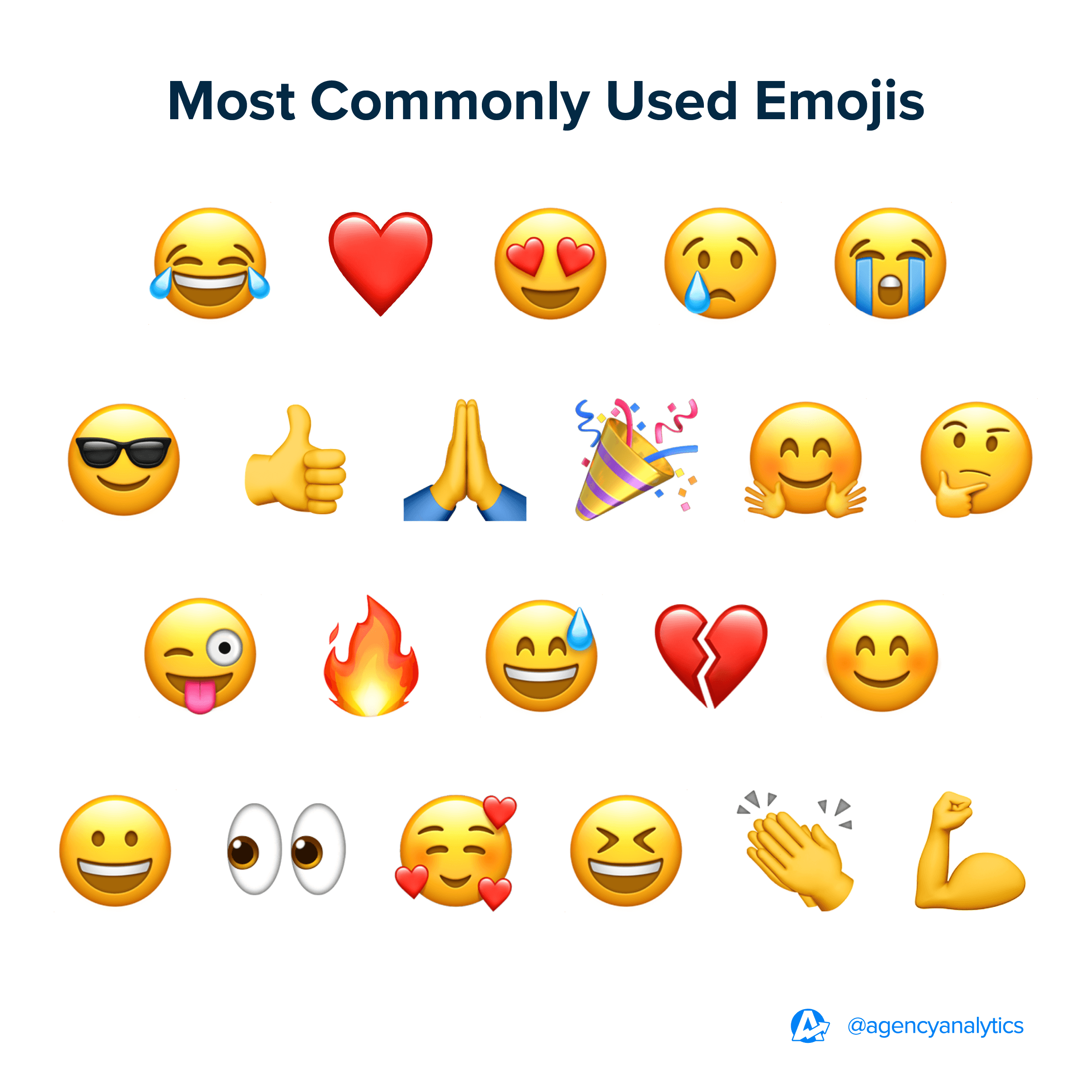
For brands, emojis aren’t just cute add-ons; they’re tools for building personal connections and adding a burst of color to everyday communication.
Emojis originated in Japan in the late 1990s. Shigetaka Kurita created them for NTT DoCoMo's mobile internet platform. Little did he know at the time that they would become a world-wide phenomenon.
The initial 176 icons were designed to convey information succinctly within the constraints of early mobile messaging.
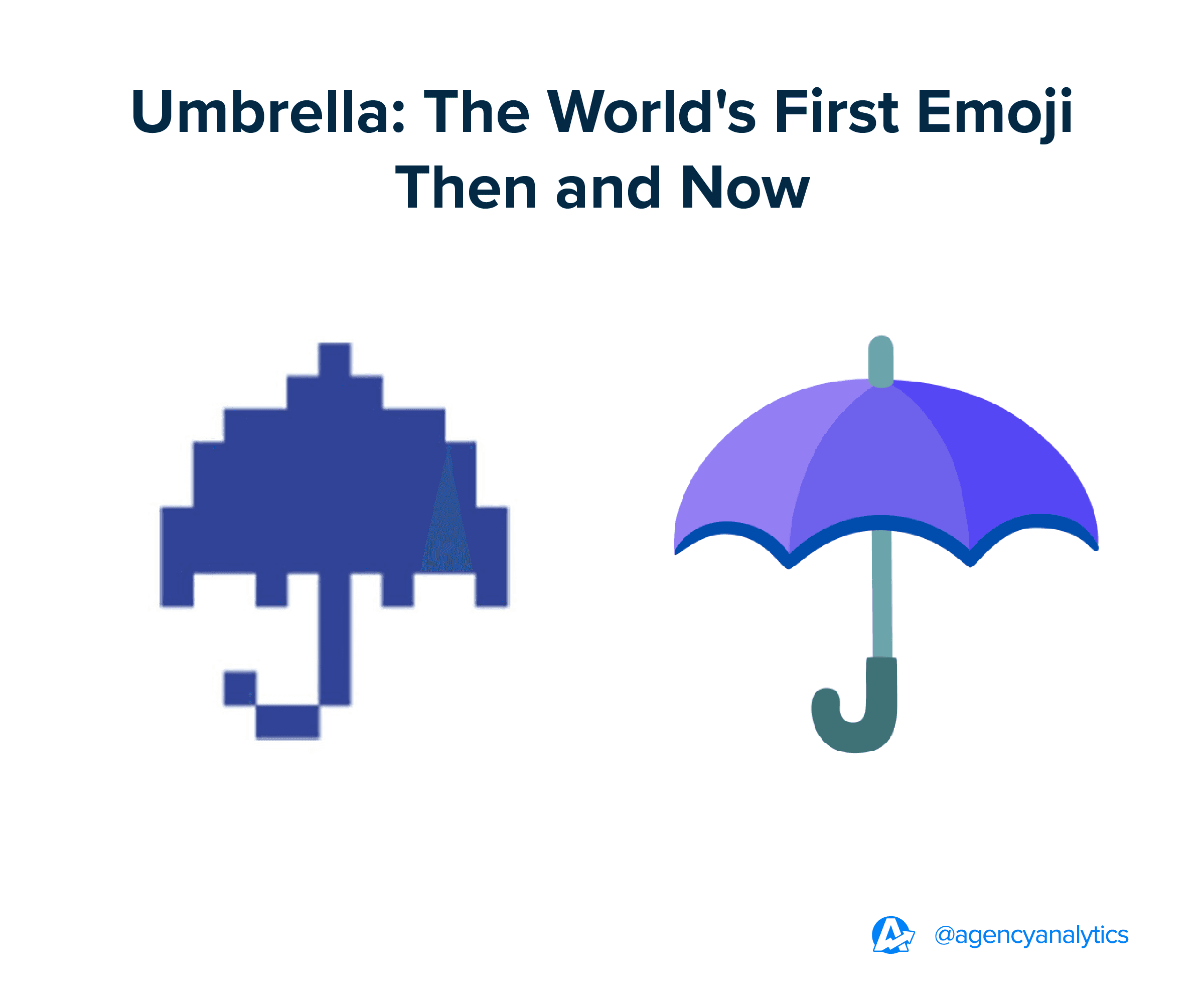
As mobile technology advanced, emojis gained popularity beyond Japan. In 2010, the Unicode Consortium standardized emojis, allowing for consistent representation across different devices and platforms. This standardization was a significant step in making emojis a global staple.
The widespread adoption of smartphones and social media platforms further propelled emoji usage. Brands began incorporating emojis into their digital marketing campaigns to engage audiences more effectively, leveraging the emotional resonance that emojis provide.
Emojis have since become integral to digital communication, with significant usage across various platforms. Here are some key emoji facts:
Every day, over 10 billion emojis are sent globally
Advertising with emojis boosts purchase intent for 44% of customers
Adding emojis to push notifications raises click-through rates by 5%
Including emojis in email subject lines increases open rates compared to text-only subject lines.
As of 2024, the Unicode Standard includes 3,790 emojis, encompassing a wide range of expressions, objects, and symbols.
These stats make one thing clear: emojis do more than decorate messages—they help brands connect. Each emoji is a tiny, expressive shortcut that brings messages to life, capturing attention and adding depth without overloading words.
👍Benefits of Using Emojis in Marketing Campaigns
With their widespread use across platforms, emojis attract attention and enhance the effectiveness of marketing campaigns. Here’s a closer look at how emojis make a difference.
Emojis as a Universal Language
One of the biggest advantages of emojis is their ability to transcend cultural and language barriers. In global digital conversations, emojis communicate emotions and ideas that words alone might not fully capture. Because emojis are universally recognized (with some cultural caveats!), they allow brands to engage audiences worldwide with a common visual language.
Enhanced Engagement
Adding emojis has been shown to increase interaction rates on social media and email campaigns. For example, studies have found that emails with emojis in subject lines see a higher open rate, while social media posts with emojis tend to generate more comments, likes, and shares.
Emotional Connection and Relatability
Emojis add a personal touch that helps audiences feel connected to a brand. They evoke emotions that make a marketing message feel warmer and more human, whether through a single smiling face or a simple thumbs-up.
Brand Tone and Personality
Emojis are also a powerful tool for conveying brand tone. Marketers reinforce their brand personality by selecting emojis that match a campaign's purpose and audience. Whether the goal is to appear playful, empathetic, or authoritative, emojis help shape how audiences perceive a brand.
Clarity and Context in Messages
Emojis help bring additional context that keeps messages clear, concise, and expressive, especially in platforms where space is limited. For instance, a message with a winking face emoji may indicate humor, while a thumbs-up can affirm a positive tone.
By leveraging the benefits of emoji use in digital marketing, brands create stronger connections, increase engagement, and communicate more effectively across audiences. With their widespread use and universally recognized meanings, emojis have become a staple in crafting impactful and memorable messages.
❤️ The 22 Most Used Emojis and Their Meanings
Emojis are everywhere, turning plain messages into something that feels real and relatable. Think of them as digital body language—the friendly wave, the warm smile, the eye-roll. They’re not just for fun; they’re a shortcut to connection, adding that extra spark to messages.
Let’s explore some of the most popular emojis, what they say (and sometimes don’t say), and a few tips to keep your messages spot-on.
Emoji Symbol | Common Emoji Name | Description, Meaning, and Popularity | Potential Misinterpretations |
|---|---|---|---|
😂 | Face with Tears of Joy | Represents laughter and joy, most commonly used to express hysterical laughter. | It may be seen as laughing at someone instead of with them. |
❤️ | Red Heart | Symbolizes love, adoration, and support, an integral part of expressing affection. | They are sometimes seen as too romantic in contexts where affection isn’t intended. |
😍 | Smiling Face with Heart-shaped Eyes | Often used to express love or admiration. | It could be interpreted as flirtatious when the intent is general appreciation. |
😢 | Crying Face | Depicts sadness, or sorrow, or upset. | It might be mistaken for extreme sorrow when intended to show minor sadness. |
😭 | Loudly Crying Face | Represents intense sorrow or profound sadness. | Can appear overly dramatic, as if reacting to something deeply upsetting. |
😎 | Smiling Face with Sunglasses | Conveys coolness, confidence, or a sense of style. | Could be perceived as aloof or detached due to the sunglasses. |
👍 | Thumbs Up | Indicates approval, agreement, or appreciation. | Sometimes, it comes across as dismissive rather than supportive. |
🙏 | Folded Hands | Shows gratitude or appreciation. | Is often misinterpreted as praying rather than thankfulness. |
🎉 | Party Popper | Celebration or excitement, especially for special occasions or milestones. | It may look out of place in non-celebratory contexts. |
🤗 | Hugging Face | Indicates warmth, affection, and support. | Sometimes misunderstood as an awkward or overly personal gesture. |
🤔 | Thinking Face | Shows contemplation or thoughtfulness. | Can be seen as sarcastic or doubtful when that’s not the intention. |
😜 | Face with Stuck-Out Tongue | A playful or joking expression that conveys sarcasm or lighthearted humor. | Might be read as rude or mocking in some situations. |
🔥 | Fire | Represents excitement or passion. | Could be interpreted as literal fire instead of symbolic passion or excitement. |
😅 | Grinning Face with Cold Sweat | Shows a mix of relief and laughter, often used in response to mildly stressful situations. | Sometimes seen as embarrassment instead of lighthearted relief. |
💔 | Broken Heart | Symbolizes heartbreak or sorrow. | Can come across as overly dramatic or theatrical when not intended. |
😊 | Smiling Face With Smiling Eyes | Represents happiness, friendliness, and positivity. | A slightly smiling face might be seen as overly polite or insincere in some contexts. |
😀 | Smiling Face with Open Mouth | Expresses happiness and excitement and is one of the most recognizable happy faces. | Could appear too generic or insincere if used in a formal message. |
👀 | Eyes | Signifies curiosity or attention. | Might be taken as prying or intrusive rather than simply observing. |
🥰 | Smiling Face with Hearts | Shows adoration, affection, and appreciation. | Could be misinterpreted as overly affectionate or romantic. |
😆 | Grinning Squinting Face | Conveys laughter or amusement, often in a light-hearted or silly context. | May be seen as mocking or overly sarcastic in certain situations. |
👏 | Clapping Hands | Used to show applause or appreciation. | Could be interpreted as sarcastic or passive-aggressive if overused. |
💪 | Flexed Biceps | Symbolizes strength or support. | Sometimes interpreted as aggressive or confrontational instead of supportive. |
New Emojis for 2025
Recently, Unicode introduced several new emojis that may enhance digital marketing strategies. Although many of these additions are not publicly available yet, they will offer fresh ways to connect with audiences and convey messages more effectively. Here are just a few of our favorites!
Emoji Name | Description and Marketing Use Case |
| The Emoji with bags under the eyes represents fatigue or stress–useful in campaigns addressing wellness or promoting relaxation products. |
| The fingerprint symbolizes identity and security– ideal for marketing services related to privacy or personalization. |
| A leafless tree depicts change or the passage of time–suitable for seasonal promotions or environmental initiatives. |
Incorporating these new emojis will add relevance and engagement to your marketing communications.
🛠️How To Use Emojis to Enhance Digital Communications
Used right, emojis do more than decorate—they spark engagement, catch eyes, and help brands stick in people’s minds. Let’s dive into some fun, practical ways to bring emojis into social media, email, search marketing, and even client reports to make every message more memorable.
Emojis in Social Media Marketing
Social media platforms like Instagram, Facebook, and LinkedIn are ideal spaces for creative emoji use.
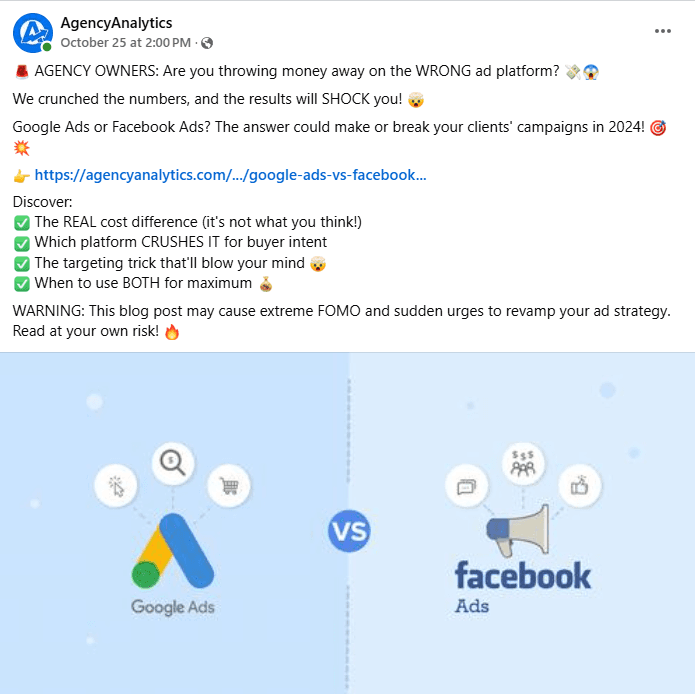
Emojis help posts stand out, convey emotion, and encourage users to interact and can increase engagement when used correctly.
Engagement Tips: Use emojis in captions to highlight key points or create visual breaks in longer posts. For X, using popular emojis like the red heart or fire emojis may increase likes and retweets.
Platform-Specific Tips: LinkedIn tends to be more formal, so opt for emojis that reflect professionalism, such as the thumbs-up or clap.
Example Campaign: A food brand might use the delicious food emoji to visually emphasize recipe posts, while a fitness brand could add the flexed biceps emoji in workout tips to reinforce the theme of strength and motivation.
Emojis are the unspoken language of social media—they’re small but powerful tools for creating quick, emotional connections.
When brands use emojis thoughtfully, it’s not just about adding flair or catching the eye of your audience; it’s about making content feel human, relatable, and worth engaging with.
The key is knowing when and where each emoji fits to reinforce the message without overwhelming it and helping translate that into positive engagement.
David Tubbs, Director of Social and Community Marketing, AgencyAnalytics
Emojis in Email Campaigns
Emojis in email subject lines and body text are like a friendly wave from the inbox—they grab attention, spark curiosity, and give messages a personal touch that boosts both open rates and engagement.
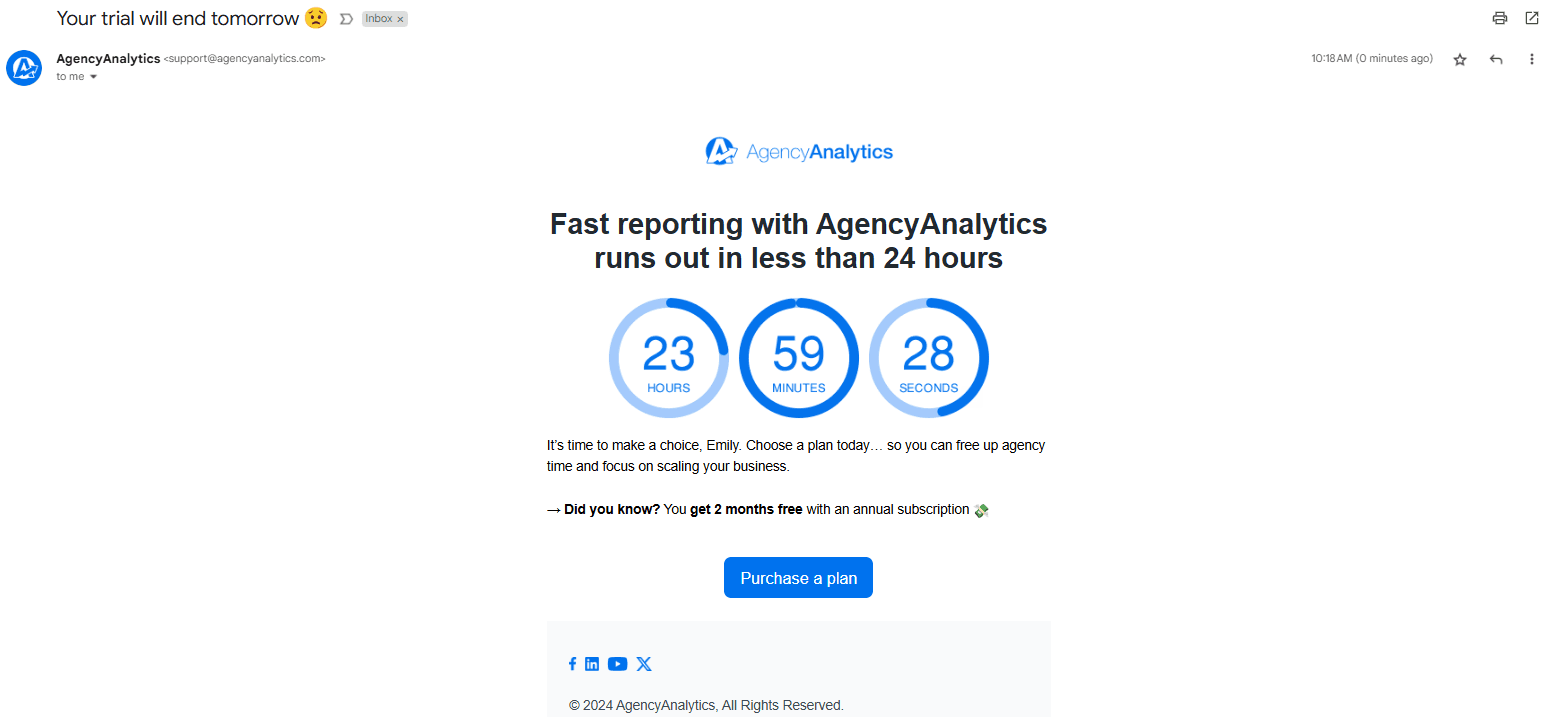
However, it’s essential to use emojis sparingly and in alignment with the message’s tone.
Usage Guidelines: Choose emojis that match the email’s purpose—such as a red heart for customer appreciation or a party popper for event invitations. Avoid overuse, which will clutter the email and potentially decrease its professional appeal.
Effective Placements: For visual impact, placing a single emoji at the start or end of a subject line often works best. In body text, use emojis to break up text or add a conversational tone without overwhelming the reader.
Emojis add a layer of personality and emotion that grabs attention in crowded inboxes, making messages feel relatable and authentic.
At AgencyAnalytics, we’ve seen how a well-chosen emoji in the subject line can increase open rates and create curiosity.
Emily Kato, Email & Life Cycle Marketer, AgencyAnalytics
Emojis in Search Marketing
Emojis are popping up more often in search results, adding personality and making listings stand out. But a little caution goes a long way—used carelessly, they may distract or even backfire.
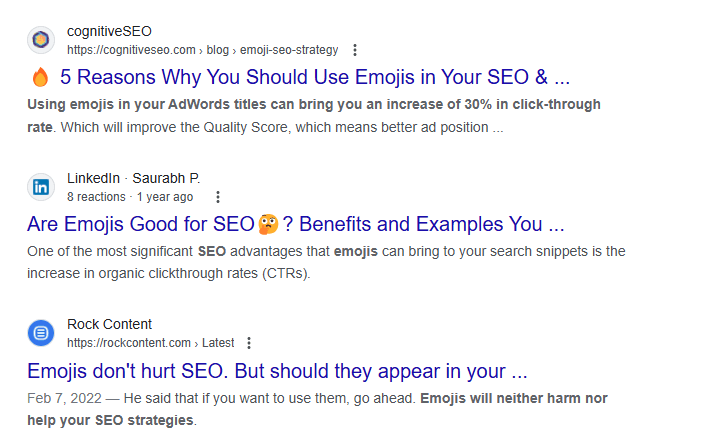
Remember, just because you squeeze an emoji into the content or metadata doesn’t mean that Google will display it. However, when done correctly, emojis in search results can boost click-through rates by making the listing stand out in a sea of sameness.
Impact on Click-Through Rates: Studies have shown that listings with appropriate emojis are more likely to capture attention. Emojis like the checkmark, red heart, or thumbs-up may add credibility to copy.
Organic Search Considerations: Google sometimes shows emojis in meta descriptions or featured snippets if they’re relevant to the query, especially for industries like food, travel, and events.
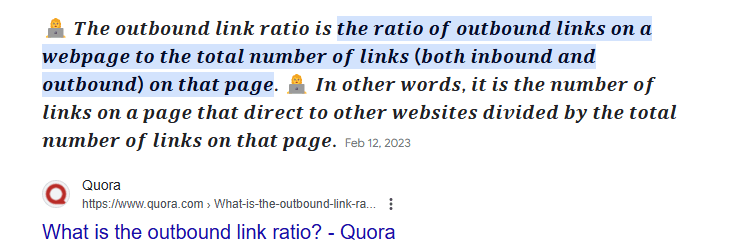
Emojis in search results give your listing that extra pop, but it's all about relevance and using an emoji the searcher will respond to. The right emoji can help your listing stand out, set the right tone for your target audience, and help increase clickthrough rates to website content.
But go overboard, and it could look cluttered or out of place. It’s about choosing emojis that make sense and add value, not just filling space.
Carson Crane, Senior SEO Strategist, AgencyAnalytics
Emojis in Client Reports
Emojis aren’t just for public-facing content—they also add a layer of engagement to client reports. When used thoughtfully, emojis make data presentations more visually engaging and help emphasize critical takeaways.
Driving Engagement: Use emojis like the red heart or clap to highlight positive metrics or milestones in client performance. For areas needing improvement, the face with tightly closed eyes or uneven eyes emoji indicates challenges without a negative tone.
Creating Excitement: Including emojis like the party popper or star eyes when showing growth or campaign successes adds an element of celebration, helping clients feel more connected to their achievements.
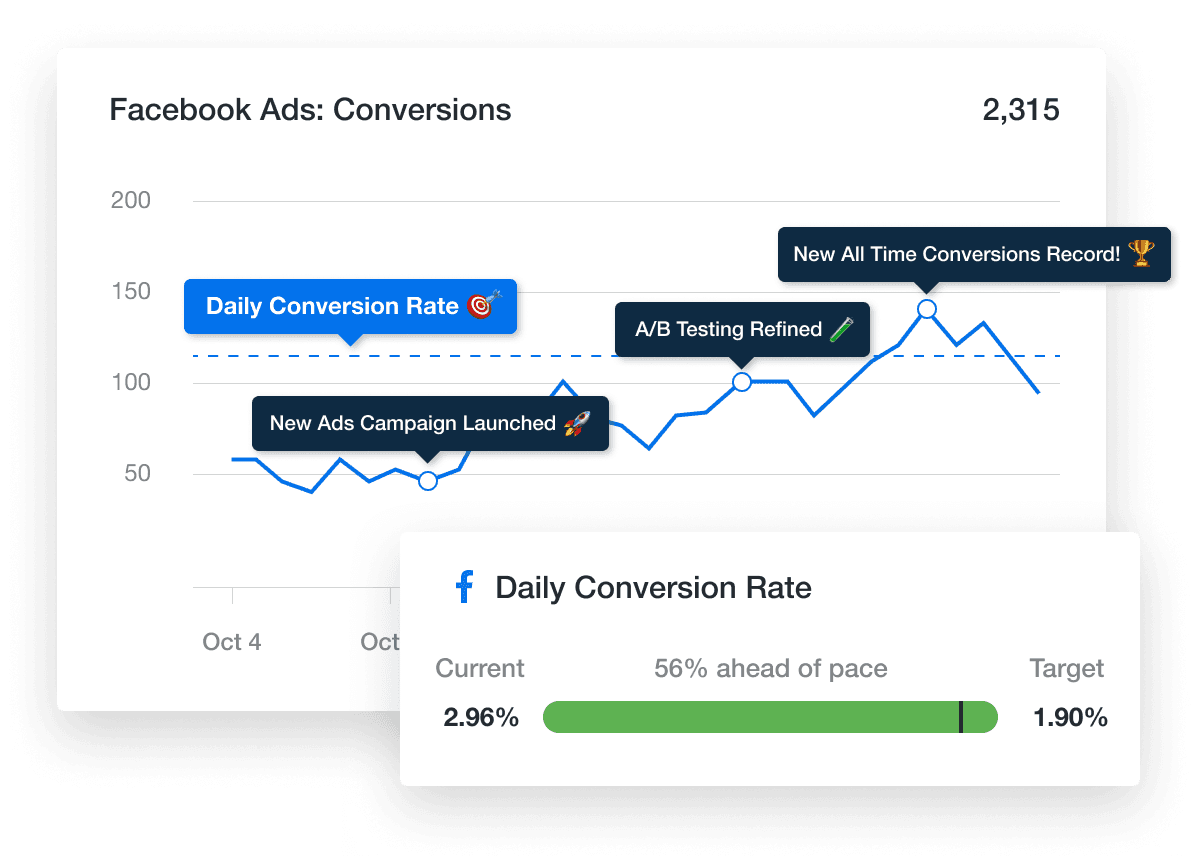
When adding custom annotations to a client report, the thumbs-up, bullseye, or rocket next to positive results or the trophy emoji next to new performance records creates clear visual cues and injects some personality into the data.
Emojis add a little personality to client reports, making key insights stand out and feel more relatable. This helps keep clients engaged with the story behind their data.
Matthew Davis, Chief Customer Officer, AgencyAnalytics
🌎Considerations for Audience Sensitivity and Cultural Nuances
Emojis are widely used but may have different meanings across cultures and contexts. After all, just because it’s in the Unicode Consortium doesn’t mean that the emoji definition is universal.
Using emojis in marketing requires both creativity and strategy. While they add personality and engagement to digital communications, they should align with the brand’s voice and be used thoughtfully to avoid potential missteps.
Do’s of Emoji Usage | Don’ts of Emoji Usage |
|---|---|
Do choose emojis that reinforce campaign objectives and match the message’s purpose. | Don’t use emojis in formal messages, legal disclaimers, or sensitive topics requiring clarity. |
Do select emojis that reflect the brand's tone. | Don’t use symbols with different meanings in specific regions or cultures. |
Do experiment with emoji placement to see where they drive the most engagement. | Don’t overload messages with emojis. |
Do use emojis that work well with screen readers. | Don’t use emojis that are ambiguous or inappropriate. |
Do keep up with trending emojis to maintain relevance. | Don’t use trending emojis if they don’t fit the brand’s tone or the message’s intent. |
Quick Tip: When targeting an international audience, research the meanings of specific emojis to ensure they resonate positively with all readers.
🚀 The Future of Emojis in Digital Marketing
Emojis aren’t just sticking around—they’re leveling up! As digital platforms expand, these little icons are opening fresh ways for brands to connect, create, and stand out. From animated emojis to custom brand icons, the emoji language is getting more dynamic, letting brands add layers of personality and interactivity that audiences love.
Emerging Emoji Trends: Recent additions to the emoji catalog, like the melting face and saluting hand, are rapidly gaining popularity, reflecting contemporary moods and digital expressions.
Interactive and Animated Emojis: The demand for interactive and animated emojis is rising, especially as social media platforms like Instagram and messaging apps explore movement in digital interactions. Marketers should watch for platforms that support these dynamic icons to experiment with them as part of their digital content strategy.
Custom Brand Emojis: Some brands are exploring personalized emojis or sticker packs, allowing customers to use branded icons in their messages. This strategy helps brands create a unique digital presence and build loyalty, as audiences associate these custom visuals directly with the brand.
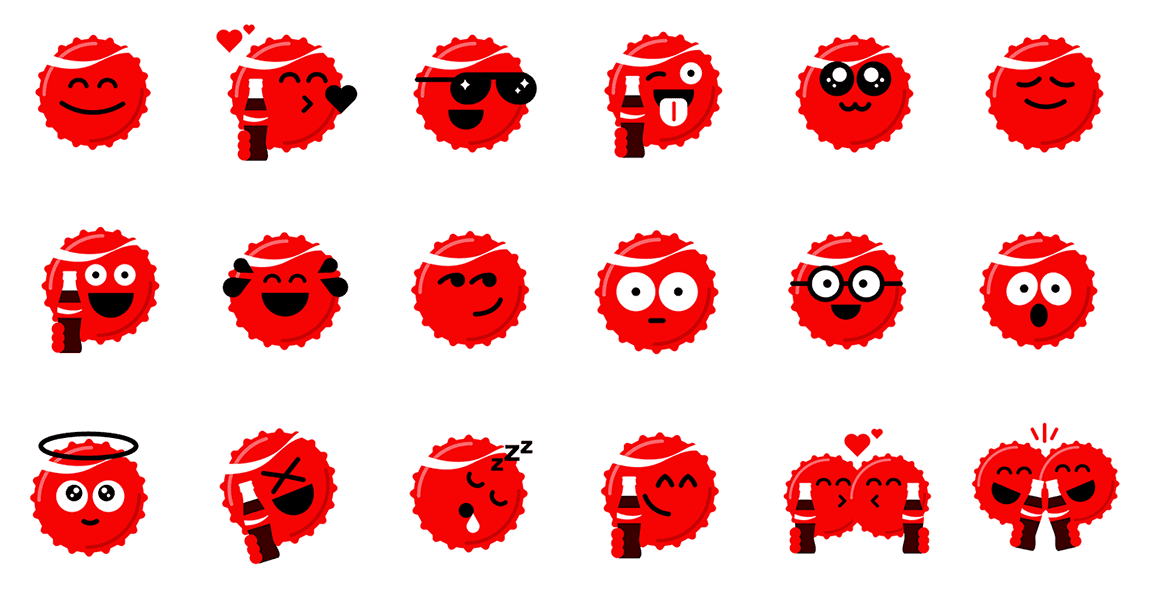
Source: Behance
📋Summary and Key Takeaways
Emojis have gone from fun extras to digital marketing must-haves, turning plain text into something with personality, warmth, and a bit of flair. They’re more than eye candy—they’re connection-builders that cross language barriers and bring real emotion into every message.
Whether it’s a friendly thumbs-up, a pointing backhand index finger, or a wavy mouth, the right emoji can make your brand feel authentic and memorable. So, next time you hit send, think about adding that perfect little icon to make your message pop!
Key Takeaways
Purposeful Use: Align emojis with campaign goals, brand personality, and target audience for the best impact.
Increased Engagement: Emojis boost interaction rates in social media, emails, and ads, making content more inviting.
Cultural Awareness: To avoid misunderstandings, remember emojis’ potential cultural interpretations.
Accessibility Matters: Choose screen reader-friendly emojis and balance visuals with text for inclusivity.
Future Opportunities: To stay current in digital engagement, monitor emerging trends, animated emojis, and custom brand emojis.
By following these guidelines, marketers use emojis effectively to enrich their digital strategies and resonate authentically with their audiences.
Which is the most used emoji in your digital arsenal? Send it to us on Facebook or LinkedIn. But no middle fingers, please!
FAQs About the Most Used Emojis
Have more questions about emojis and their meanings? We’ve got you covered!
Emojis help marketers connect with audiences faster and more authentically. They convey tone, spark emotion, and add clarity, especially on platforms with limited space. Used strategically, emojis increase engagement across social, email, and search by turning plain text into something human and relatable.
The “Face with Tears of Joy” 😂 remains the most used emoji worldwide. It signals laughter and lightheartedness, often used to show that something is genuinely funny or amusing.
Yes. Some emojis carry different meanings across cultures and regions. For example, the “Folded Hands” emoji 🙏 is seen as thankfulness in many Western contexts but is often interpreted as a prayer gesture elsewhere. Always research emoji meanings when targeting international audiences.
Choose emojis that align with the message, match the brand tone, and enhance clarity. Avoid overuse, test placement (especially in subject lines), and be mindful of accessibility.

Written by
Paul Stainton is a digital marketing leader with extensive experience creating brand value through digital transformation, eCommerce strategies, brand strategy, and go-to-market execution.
Read more posts by Paul StaintonSee how 7,000+ marketing agencies help clients win
Free 14-day trial. No credit card required.



